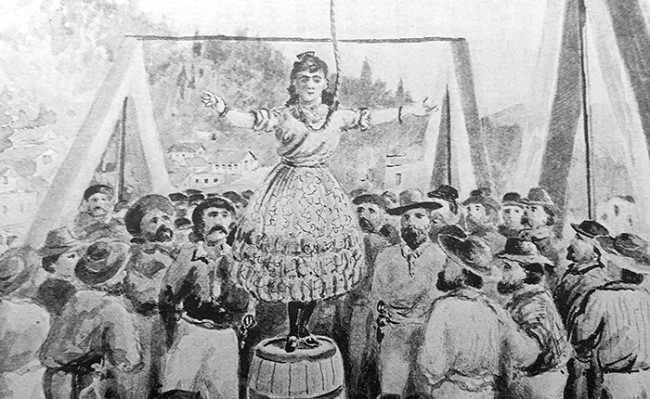Laws & Rights
NRA-ILA: Felonies Ain’t What They Used to Be

The hanging of “Pretty Juanita,” who probably should have been exonerated for self-defense.
We, as a society, have defined “dangerous” down. That’s a bad thing.
When most of us–even the most dedicated pro-2A activists–hear about gun laws that prevent convicted felons from possessing firearms, we shrug. That’s because most of us have a different definition of a “felon” than much of the U.S. government. As NRA’s Institute for Legislative Action points out in today’s column, the ol’ gray felony just ain’t what she used to be. When the Bill of Rights was drafted, the list of crimes that could get you disarmed was almost the same list of crimes that could get you the death penalty.
These days, a felony could be something as simple as chirping your tires on the wrong street art. Or not realizing that the private gun sale that was legal last week is not legal this week. Everyone in the justice system, from the bureaucrats who wrote those laws to the cops who have to enforce them, know perfectly well that the teen who did a burnout on a Pride flag is not a dangerous person. Martha Stewart isn’t a dangerous person. Hunter Biden is only dangerous to unmonitored Tony-Montana-size piles of yayo.
We, as a society, have defined dangerous down. That’s a huge problem, because you cannot keep guns out of the hands of “dangerous” people without having a robust picture of what danger is. The NRA-ILA has more thoughts.
~~~~~~~~~~~~~~~~~~~~~~~~~~~~~~~~~~~~~~~~~~~~~~~~~
In recent years, many on the political left had encouraged use of the politically correct term “justice-involved individual” to refer to those convicted of, even serious, crimes. That is, until May 30. Upon that date, the great and the good rediscovered the pejorative “felon.” While their cynical use of the term is meant to conjure ideas of dangerousness and other severe negative connotations, such notions at this late date are dubious. Simply put, felonies aren’t what they used to be.
Traditionally, there were nine common law felonies. These included: murder, rape, manslaughter, robbery, sodomy, larceny, arson, mayhem, and burglary. Note that all but one of these crimes involves dangerous conduct involving direct attacks on another person or their property. The consensual form of the remaining crime has been abolished (Lawrence v. Texas (2003)). The remaining common law felonies are simple, have tangible victims, and are understandable to all but the most deranged as severe wrongdoing.
With the United States’ ever-growing reams of federal and state statutes and the bureaucrat-made law in the Code of Federal Regulations and state analogues accompanying it, this is no longer the case.
U.S. Supreme Court Justice Neil Gorsuch has made clear that he understands this issue.
The 2021 Supreme Court case Lange v. California involved the question of whether, under the Fourth Amendment, a law enforcement officer may always pursue an individual suspected of having committed a misdemeanor into a home without obtaining a warrant. The Court held that such a categorical exemption to the warrant requirement was impermissible.
During oral arguments there was much discussion on how to treat misdemeanor versus felonious conduct in such circumstances. Understanding the creeping expansion of the definition of felony, Gorsuch defended broad Fourth Amendment protections, noting,
we live in a world in which everything has been criminalized. And some professors have even opined that there’s not an American alive who hasn’t committed a felony in some – under some state law.
Gorsuch went on to explain,
what qualified as a felony at common law was — were very few crimes and they were all punished by the death penalty usually, and today pretty much again anything or everything can be called a felony.
In 2009, civil rights attorney and co-founder of the Foundation for Individual Rights and Expression Harvey Silverglate published the provocative book Three Felonies A Day: How the Feds Target the Innocent. The thesis of the book is that with the United States’ departure from the common law, almost every American is unwittingly guilty of a felony under the ever-expanding thicket of vague federal and state statutes and regulations.
The ridiculous nature of modern felonies should be easy for gun owners to grasp.
Consider the ATF’s bump stock rule. As U.S. Supreme Court Justice Clarence Thomas recently pointed out in his opinion in Garland v. Cargill (2024), for years bump stocks were sold in the U.S. with the blessing of the ATF. Then, in 2017 ATF reversed its own regulatory guidance and purported to outlaw the devices as “machineguns.” Under ATF’s rule, those who did not dispose of their lawfully-acquired property would commit a felony. It didn’t matter if a person was peaceful and otherwise law-abiding, mere continued possession of a lawfully-acquired item could subject them to a felony conviction.
As it turns out, ATF’s recent reinterpretation of federal statute was bogus all along and was thus overturned by the Supreme Court. However, the federal government’s behavior in this case is a testament to just how frivolous they are in concocting and defending new nonviolent felonies.
This wild expansion of felonies has a significant impact on Second Amendment rights.
Generally, federal law prohibits felons from possessing firearms. The Gun Control Act of 1968, as codified at 18 USC 922(g)(1), prohibits firearm possession by any person “who has been convicted in any court of, a crime punishable by imprisonment for a term exceeding one year.”
The meaning of that language is pared down in 18 USC 921(a)(20), which states,
(20) The term “crime punishable by imprisonment for a term exceeding one year” does not include–
(A) any Federal or State offenses pertaining to antitrust violations, unfair trade practices, restraints of trade, or other similar offenses relating to the regulation of business practices, or
(B) any State offense classified by the laws of the State as a misdemeanor and punishable by a term of imprisonment of two years or less.
As one can see from 18 USC 921(a)(20)(A), even in 1968 lawmakers understood that it didn’t make sense to categorically prohibit anyone convicted of any felony, such as the obviously nonviolent, from possessing firearms. However, with such a limited carveout, those lawmakers perhaps failed to anticipate the sprawling growth of government.
The U.S. Supreme Court rulings in District of Columbia v. Heller (2008) and New York State Rifle & Pistol Association Inc. v. Bruen (2022) made clear that that the Second Amendment right and impositions on it must be considered in light of the nation’s historical tradition. Given the current reality around felonies, and just how much it differs from the historic record, there has been renewed interest in cabining the 18 USC 922(g)(1) prohibition and state analogues to those convicted of violent crimes or at least crimes indicative of some amount of dangerousness.
In 2009, the Harvard Journal of Law & Public Policy published a widely circulated item written by former Deputy Assistant Attorney General C. Kevin Marshall with a title that posed the reasonable question “Why Can’t Martha Stewart Have a Gun?” In it Marshall explained,
In 2004, domestic diva Martha Stewart was convicted of obstruction of justice, making false statements, and two counts of conspiracy in connection with dubious stock transactions. Although sentenced to only five months in jail plus a period of supervised release, she risked a much harsher punishment. Because she was convicted of a crime punishable by more than a year in prison, federal law bans her from having any gun.
…
Is the public safer now that Martha Stewart is completely and permanently disarmed? More to the point, how could such a ban be constitutional, now that the Supreme Court, in District of Columbia v. Heller, not only has confirmed that the Second Amendment secures a personal right to keep and bear arms, but also has emphasized its historical tie to the right of self‐defense?
Marshall endorses a regime that would limit firearm prohibitions to those convicted of crimes of violence. The author noted,
the “crime of violence” concept developed then tracks, both historically and rationally, the basis on which a disability should proceed constitutionally: by focusing on convictions indicating that one actually poses some danger of physically harming others rather than simply being dishonest or otherwise unsavory.
Disabilities based on a conviction ought to rest on a justification sufficient to override or qualify the right of self‐defense underlying the Second Amendment, and the “crime of violence” concept does so.
Likewise, in 2019 Justice Amy Coney Barrett, then a judge on U.S. Court of Appeals for the Seventh Circuit, suggested that firearm possession prohibitions should be tied to dangerousness while dissenting in the case Kanter v. Barr. The case involved the Second Amendment rights of an individual with a felony mail fraud conviction stemming from the almost comically nonviolent crime of selling Medicare non-compliant therapeutic shoe inserts.
Taking issue with the categorical ban on felons possessing firearms, Barrett explained,
History is consistent with common sense: it demonstrates that legislatures have the power to prohibit dangerous people from possessing guns. But that power extends only to people who are dangerous. Founding-era legislatures did not strip felons of the right to bear arms simply because of their status as felons.
The federal and state governments’ campaigns to criminalize everything, that Justice Neil Gorsuch so aptly pointed out, show little sign of abating. This, along with the decisions in Heller and Bruen, should prompt a serious examination as to the legality and efficacy of blanket prohibitions on felons possessing firearms.
-

 Breaking News1 month ago
Breaking News1 month agoNaked: Kirk Slaying Exposes Left’s Lust for Violence
-

 Breaking News1 month ago
Breaking News1 month agoCharlie Kirk Assassinated: Details, Reactions & Manhunt (Photo Released)
-

 Breaking News2 months ago
Breaking News2 months agoSecond Amendment Wins: Top Gun Rights Victories This Week
-

 Action Alerts1 month ago
Action Alerts1 month agoCharlie Kirk Assassination Ignites Woke Right Awakening
-

 Action Alerts1 week ago
Action Alerts1 week agoPam Bondi Gun Registry: 2A Blocks Reese v. ATF Overreach
-

 Breaking News1 month ago
Breaking News1 month agoCalifornia Glock Block: Sacramento’s Gun Ban
-

 2A Living3 weeks ago
2A Living3 weeks agoYouTube’s Demonetization of Gun Videos: 2A Rights Defense
-

 2A's Lighter Side2 weeks ago
2A's Lighter Side2 weeks agoAmazon Bond Poster Edits: Backlash & Franchise Fears





